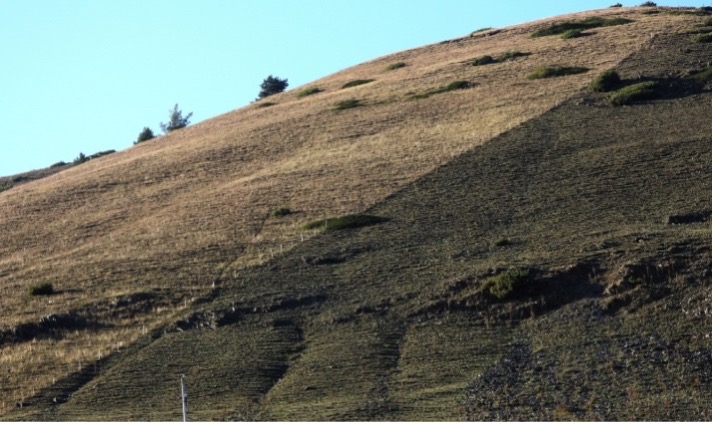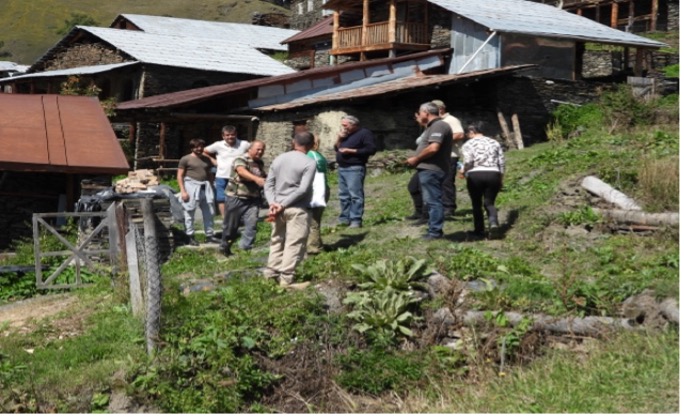Flourishing Dams

Summary
The project – Integrated Erosion Control” (IEC) and “Integrated Biodiversity Management, South Caucasus” (IbiS) was financed and implemented by GIZ between 2014-2019. For the integrated erosion control component, the project piloted measures in Tusheti, Georgia to create infrastructure for effective pasture management. Friends Association of Tusheti Protected Areas (FATPA) and Tusheti Protected Landscape Administration (TPLA) were local partners and involved during the implementation process.
Sheepherding is a traditional and deeply rooted activity in the Tusheti region, located in the mountains of north-eastern Georgia. The region is renowned for producing high-quality wool and Tushetian Guda cheese. The landscape is particularly suitable for herding, with high mountains and steep slopes offering large areas for pasture. Over the centuries, human activity has shaped this landscape, reducing forest cover to free up space for pasture.
Until the end of the Soviet era, herding was a profitable activity sustaining livelihoods in the mountains. Cattle herding has since been unregulated and left the land significantly more exposed to land erosion. Erosion is now threatening infrastructures such as houses, farms, and road networks across the region.
By 2050, Georgia is expected to experience an average temperature rise of about 0.8-1.4°C, along with an increased incidence of natural hazards including landslides, mudslides, floods, and droughts. It is also expected that heavy precipitation events will increase in Georgia, and the mountainous region of Tusheti will experience less predictable rainfall. This, combined with unsustainable land use, will further increase the risk of erosion, landslides, and mudslides.
Overview
- Location:
- Implementation sites:
-
- Single country
- Multiple locations
- Mountain region:
-
Jvarboseli and Shenako villages in Tusheti
- Solution scale:
- Ecosystem type(s):
- Solution type(s):
- Other Solution(s) type(s):
-
- Bio-engineering
- Sector(s):
- Climate impact(s) addressed:
- Climate impact time-scale(s):
- Main benefit associated with the solution:
- Co-benefit(s) associated with the solution implementation:
- Implementation timeline:
-
- 2014 - 2019
- Sendai targets:
-
Solution details
Main beneficiaries & outcomes
The project initiated a combination of the solutions as a treatment and implemented in the two villages of Jvarboseli and Shenakho. In total, 27 erosion-limiting structures were installed in gullies to prevent further erosion and stabilize the soil to enable vegetation regrowth. More than 400 meters of gullies’ overhanging edges were rounded and prepared for replanting. An additional several rows were dug upstream of the main gullies. About 5,000 tree seedlings – mostly local Scots pine (Pinus sylvestris) and Goat willow (Salix caprea), but also bushes such as Tscirtsceli (Sorbus caucasigena) and common Juniper (Juniperus communis) were planted in the upper parts of the village. Raspberry, a thorny bush, was also planted to deter animals from eating the small plants and seedlings. A total of 28.7 hectares of pasture were included in the rotational grazing scheme.
The main beneficiaries of the solution are the local residents and landowners of the selected villages in Tusheti, Georgia. The solution resulted in:
– improved pasture restoration;
– reduced damage-causing by natural disasters such as avalanches and downpouring as the healthy soil has the ability to restrain the water;
– better awareness of local residents of the results of overgrazing and rotational grazing method as well as using the simple machinery to adapt climate-related natural disasters
Planning and implementation
The project started in 2014 and was implemented by the FATPA – Friends Association of Tusheti Protected Areas and TPLA – Tusheti Protected Landscape Administration.
Reversing land erosion is no simple task and requires an integrated approach combining different aspects to consider. The two villages of Jvarboseli and Shenakho were part of an initiative applying an integrated approach which included erosion control in gullies, tree planting and rotational grazing.
Erosion gullies are constantly getting larger and deeper, such as the one in Jvarboseli village which was formed after a large-scale landslide in 2004. The gullies expand because vegetation does not grow due to excessive erosion. This leads to a lack of root systems to stabilize the soil, creating a vicious circlea continues again erosive processes. To break this cycle and improve conditions for vegetation to grow in the erosion gullies of both villages, vegetated wooden check dams were used to stabilize the beds of these steep gorges. The check dams were made from large pieces of wood assembled in a three-layer horizontal structure, filled with drainage material and reinforced by locally available stones to prevent the structure from eroding. Living branches and rooted woody plants were inserted into the side walls without blocking the discharge section. Additional measures were applied on the overhanging edges of gullies by rounding them and preparing them for replanting to ensure vegetation growth. In certain cases, the upper parts of the gullies were also targeted by creating tranches perpendicular to the slope and planting appropriate vegetation.



1/Sketch of the structure of Wooden check dams (from Rauch et al., 2016) 2/ Wooden check dams installed in a gully in Jvarboseli village (Before /Afte). Crdits: @GIZ 2019/ @Sustainable Caucasus
In order to stabilize the soil 3,000 seedlings of local tree species were planted in strategic places along the upper parts of Jvarboseli village. Reforestation strengthens ecosystem services, e.g. by regulating water movement, filtering water and air and forming a natural barrier that helps decrease the village`s risk of landslides, mudslides and avalanches (Makino and Rudolf-Miklau 2021).
One further activity of this integrated erosion control solution was the introduction of rotational grazing, which can be an effective tool for pasture management, giving plants time to grow and thus limiting soil erosion. Rotation pastures systems operate with several pasture units (paddocks) divided by fences. While one pasture unit is used, the grasses and herbs can grow back on the other paddocks within a regeneration period of four to six weeks (GIZ 2019). It is sometimes considered the most effective measure to stop erosion if coupled with a wider pasture management scheme and supported by governing structures at the local and regional level to establish knowledge and infrastructure for pasture monitoring (Neudert et al. 2019). Monitoring and in-depth knowledge are important since rotational grazing can have adverse effects if done incorrectly, e.g., if resting periods are too short (Weber and Horst 2011).
In the village of Shenakho, rotational grazing was introduced by dividing the upper part of the village into different paddocks. In another part of the village, fences were installed to prevent livestock from entering specific parcels of land and ensure fast recovery of the vegetation. Farmers in both Shenakho and Jvarboseli as well as regional and national experts also received theoretical and practical training, which will help them to pass on the methods within their communities and to other areas.
Finance
The project was financed by the GiZ – Deutsche Gesellschaft für Internationale Zusammenarbeit
Innovation
To reverse land erosion, this project initiated an integrated approach consisting of erosion control through wooden check dams, tree planting, and rotational grazing.
Long term project sustainability and maintenance
Tusheti Protected Landscape Administration operates locally and in close relationship with the local residents monitors the rotational grazing to keep the measure on its track and ensure the project’s integrated approach effectiveness.

Rotational pasture delimited by a fence in Shenakho village. @Sustainable Caucasus
Capacities for design and implementation
Knowledge
Based on the experiences generated from the pilot solutions, the project created a practical handbook guide for planning and implementing integrated erosion control measures in Georgia. The handbook includes information on soil erosion processes in Georgia and way to mitigate their negative impacts, it presents showcases as a lesson learned from the pilot area, also includes useful factsheets for farmers and landowners to implement in their fields.
Institutional

Villagers in Tusheti. @Sustainable Caucasus
Irakli Aptarauli, Head of Natural Resource Management at Tusheti Protected Landscape: “First we need to recognize the causes and then find the solution of erosion. In the case of Tusheti, overgrazing was a major problem that resulted in the loss of the plant root systems and the development of large and deep gorges which became the location for recurrent landslides. We first treated the causes and set fences to avoid grazing activities in the damaged area over the gorge. We got positive outcomes from this project.”
Outlook & Scalability
Potential for upscaling and replication
These measures are applicable for municipalities facing water-induced erosion processes and pressure from unsustainable herding practices. The presented solution can be implemented with relatively simple machinery and few resources, using local tools and materials. Important aspects to consider include building local ownership and capacity, supported by training on the theoretical approach and practical exercises in the field, and continued monitoring.
As above mentioned, the project invented the practical handbook which can be used for training or guiding material to replicate the measures this project undertook in Tusheti. Additionally, based on the knowledge generated from the pilot solutions, the Natural Resource Management at Tusheti Protected Landscape with the support of GIZ prepared short video tutorials for erosion control and effective management in the Georgian language and shared them on Youtube to be accessible to anyone needs to implement practical solutions.



Comments
There is no content